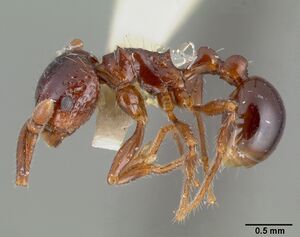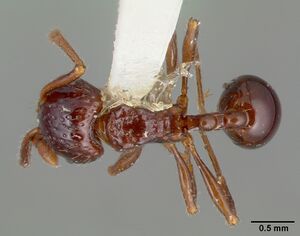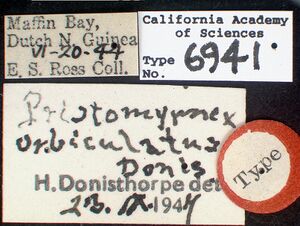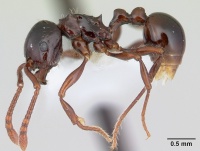Pristomyrmex quadridens
| Pristomyrmex quadridens | |
|---|---|

| |
| Scientific classification | |
| Kingdom: | Animalia |
| Phylum: | Arthropoda |
| Class: | Insecta |
| Order: | Hymenoptera |
| Family: | Formicidae |
| Subfamily: | Myrmicinae |
| Tribe: | Crematogastrini |
| Genus: | Pristomyrmex |
| Species: | P. quadridens |
| Binomial name | |
| Pristomyrmex quadridens Emery, 1897 | |
| Synonyms | |
| |
This species occurs in rainforest and has been collected in litter, in a rotten branch, and under the bark of a log. Zettel noted a nest of P. quadridens was discovered in a piece of rotten wood (dimensions about 15 × 20 × 50 cm) laying on the moist soil and rocks on a river bed.
Identification
Wang (2003) - Worker. Pronotum and propodeum each with a pair of short spines; dorsal surfaces of alitrunk and head between the frontal carinae with scattered foveolate punctures; petiole node and postpetiole each with at least a pair of hairs; HW 0.82-1.02, HL 0.82-1.02.
This species occurs in New Guinea, some islands near New Guinea, and Pohnpei Island. One of its closely related species, P. brevispinosus, is distributed in Indonesia, Malaysia, Thailand, the Philippines, Taiwan, and Japan; in other words, Pristomyrmex brevispinosus occurs to the northwest of P. quadridens. The differences between the workers of the two species are as follows: The dorsal surfaces of the head and the alitrunk possess scattered foveolate punctures in P. quadridens but foveolate-reticulate sculpture or rugoreticulum in P. brevispinosus.
Characters separating P. quadridens from Pristomyrmex nitidissimus of New Guinea are presented under P. nitidissimus. The three Australian species, Pristomyrmex wheeleri, Pristomyrmex erythropygus, and Pristomyrmex quadridentatus, differ from P. quadridens in the workers in having three strong teeth on the anterior clypeal margin, three teeth on the masticatory margin of the mandible, longer pronotal armaments, palp formula of 2,2, and lacking foveolate punctures on the dorsal surfaces of the head and the alitrunk.
A member of the Quadridens species group
Keys including this Species
- Key to Micronesian Ants
- Key to Pristomyrmex of the Philippines
- Key to Pristomyrmex workers
- Key to Subfamily of Philippine Ants
Distribution
Latitudinal Distribution Pattern
Latitudinal Range: 7.60139° to -9.25°.
| North Temperate |
North Subtropical |
Tropical | South Subtropical |
South Temperate |
- Source: AntMaps
Distribution based on Regional Taxon Lists
Indo-Australian Region: Indonesia, Micronesia (Federated States of), New Guinea (type locality), Palau, Philippines.
Distribution based on AntMaps
Distribution based on AntWeb specimens
Check data from AntWeb
Countries Occupied
| Number of countries occupied by this species based on AntWiki Regional Taxon Lists. In general, fewer countries occupied indicates a narrower range, while more countries indicates a more widespread species. |

|
Estimated Abundance
| Relative abundance based on number of AntMaps records per species (this species within the purple bar). Fewer records (to the left) indicates a less abundant/encountered species while more records (to the right) indicates more abundant/encountered species. |

|
Biology
|
Castes
Worker
Images from AntWeb
   
| |
| Syntype of Pristomyrmex orbiculatus. Worker. Specimen code castype06941. Photographer April Nobile, uploaded by California Academy of Sciences. | Owned by CAS, San Francisco, CA, USA. |
Nomenclature
The following information is derived from Barry Bolton's Online Catalogue of the Ants of the World.
- quadridens. Pristomyrmex quadridens Emery, 1897c: 584, pl. 15, fig. 25 (w.q.) NEW GUINEA. Wang, M. 2003: 461 (m.). Senior synonym of aruensis, orbiculatus: Wang, M. 2003: 459.
- aruensis. Pristomyrmex quadridens var. aruensis Karavaiev, 1933c: 270 (w.) INDONESIA (Aru I.). See also: Karavaiev, 1935a: 99. Junior synonym of quadridens: Wang, M. 2003: 459.
- orbiculatus. Pristomyrmex orbiculatus Donisthorpe, 1948b: 306 (w.q.m.) NEW GUINEA. Junior synonym of quadridens: Wang, M. 2003: 459.
Unless otherwise noted the text for the remainder of this section is reported from the publication that includes the original description.
Description
Worker
Wang (2003) - TL 3.34-4.10, HL 0.82-1.02, HW 0.82-1.02, C1 96-102, SL 0.86-1.00, SI 96-105, EL 0.14-0.20, PW 0.54-0.70, AL 0.82-1.04, PPW 0.24-0.28, PPL 0.26-0.30, PPI 86-100 (n = 30).
Mandibles usually smooth and shining but sometimes with a few fine longitudinal rugae. Dentition of the masticatory margin of mandible: the strongest apical tooth + the second strongest preapical + a long diastema + two small teeth that are roughly the same size; sometimes two small basal teeth are fused, forming a broad tooth with two points. Basal margin of mandible lacking a distinct toothlike prominence. Clypeus depressed and smooth, with a median longitudinal carina, but sometimes this median carina weak or absent. Anterior clypeal margin usually with a median denticle and two to three others on each side. Ventral surface of clypeus with a toothlike prominence at the center. Palp formula 1,3. Frontal carinae distinct, extending to the level of the posterior margins of eyes. Antennal scrobes shallow and short. Frontal lobes weak; thus, the antennal articulations are almost entirely exposed. Antennal scapes, when lying on the dorsal head, slightly surpassing the occipital margin of head. Eyes usually containing seven to eight ommatidia in the longest row. Occipital margin feebly concave. Pronotum armed with a pair of acute short spines. Propodeum with a pair of triangular teeth or short spines that are about equal in length to the pronotal armaments. Metapleural lobes rounded or with a subtriangular apex. Petiole node in profile nodiform; its anterodorsal angle high, and the dorsum sloping downward posteriorly. Postpetiole in profile rounded dorsally, in dorsal view broadening from front to back and usually longer than broad but sometimes about as long as broad. Dorsum of head between the frontal carinae with scattered foveolate punctures; intensity and number of punctures very variable: The punctures are sometimes dense and large but sometimes few, small, and shallow. Dorsum of alitrunk with scattered foveolate punctures, varying from a few to many. Petiole, postpetiole, and gaster unsculptured, smooth, and shining. Dorsal surfaces of head and alitrunk with numerous erect or suberect hairs. Two pairs of hairs usually present on the dorsum of petiole node and a pair usually on the dorsum of postpetiole. First gastral tergite without erect or suberect hairs. A few pairs of forward-projecting hairs present near the anterior clypeal margin. Scapes and tibiae with abundant erect to suberect short hairs. Color varying from light yellow-brown to dark-brown; in some specimens, a darker circular patch present on the dorsum of head just above the frontal area; sometimes gaster darker than head and alitrunk.
Queen
Wang (2003) - TL 3.82-4.72, HL 0.90-1.10, HW 0.94-1.11, CI 98-10,5, SL 0.88-1.02, SI 90-99, EL 0.23-0.28, PW 0.74-0.88, AL 1.06-1.26, PPW 0.26-0.32, PPL 0.29-0.34, PPI 88-97 (n = 7).
General shape with normal caste differences from the conspecific worker; pronotum unarmed. Other characters similar to worker.
Male
Wang (2003) - Two male specimens, together with 12 workers and two queens, constitute a series collected in Indonesia (Seram, above Haruru, near Masohi, 50-150 m) by W L. Brown; each of the two males was originally mounted with a worker on the same pin: TL 3.30, 3.52; HL 0.60, 0.62; HW 0.60, 0.62; CI 100, 100; SL 0.23, 0.24; SI 38, 39; HWE 0.80, 0.82; EL 0.32, 0.33; PW 0.79, 0.82; AL 1.20, 1.20; PPW 0.22, 0.22; PPL 0.25, 0.27; PPI 81, 88 (n = 2).
Head, including the eyes, distinctly broader than long. Clypeus somewhat transverse, convex, and unsculptured. Palp formula 1,3. Frontal carinae absent. Maximum diameter of the median ocellus 0.11 to 0.12. On the mesoscutum, notauli pronounced, forming a Y shape; parapsidal furrows very weak. Scuto-scutellar sulcus with 10 narrow longitudinal ridges. Propodeum tuberculate, lacking teeth or spines. Metapleural lobes somewhat rounded. Petiole node in profile low and rounded dorsally, with a fairly long anterior peduncle. Postpetiole low, in dorsal view distinctly longer than broad. Dorsum of head smooth and shining. Alitrunk smooth and shining, except for those marked sutures. Petiole, postpetiole, and gaster smooth and shining. All dorsal surfaces with abundant long hairs. Scapes and tibiae with numerous erect or suberect short hairs. Color blackish-brown; hairs reddish-brown; wings somewhat infuscated.
Wang (2003):
Lectotype worker, New Guinea: Friedrich-Wilhelmshafen et Berlinhafen (L. Biro) (Museo Civico di Storia Naturale, Genoa), here designated, [examined].
Pristomyrmex quadridens aruensis. Holotype worker, Indonesia: Aru Is ., Wammar (W. Karawajew) (UENC) [examined].
Pristomyrmex orbiculatus. Syntype workers, queens and males, New Guinea: Maffin Bay, 20.vi.1944 (E. S. Ross) [syntype workers (The Natural History Museum, Los Angeles County Museum of Natural History, National Museum of Natural History) examined].
References
- Emery, C. 1897c. Formicidarum species novae vel minus cognitae in collectione Musaei Nationalis Hungarici quas in Nova-Guinea, colonia germanica, collegit L. Biró. Természetr. Füz. 20: 571-599. (page 584, pl. 15, fig. 25 worker, queen described)
- Radchenko, A.G., Fisher, B.L., Esteves, F.A., Martynova, E.V., Bazhenova, T.N., Lasarenko, S.N. 2023. Ant type specimens (Hymenoptera, Formicidae) in the collection of Volodymyr Opanasovych Karawajew. Communication 1. Dorylinae, Poneromorpha and Pseudomyrmecinae. Zootaxa, 5244(1), 1–32 (doi:10.11646/zootaxa.5244.1.1).
- Wang, M. 2003. A Monographic Revision of the Ant Genus Pristomyrmex (Hymenoptera:Formicidae). Bulletin of the Museum of Comparative Zoology 157(6): 383-542 (page 459, Senior synonym of quadridens var. aruensis and orbiculatus; page 461, fig. 160-161, 274 queen, male described)
- Zettel, H. 2006. On the ants of the Philippine Islands: 1. The genus Pristomyrmex Mayr, 1866. Myrmecologische Nachrichten 8:59-68.
References based on Global Ant Biodiversity Informatics
- CSIRO Collection
- Chapman, J. W., and Capco, S. R. 1951. Check list of the ants (Hymenoptera: Formicidae) of Asia. Monogr. Inst. Sci. Technol. Manila 1: 1-327
- Clouse R. M. 2007. The ants of Micronesia (Hymenoptera: Formicidae). Micronesica. 39: 171-295.
- Clouse, R.M. 2007. The ants of Micronesia (Hymenoptera: Formicidae), Micronesica 39(2): 171-295.
- Donisthorpe H. 1948. A second instalment of the Ross Collection of ants from New Guinea. Annals and Magazine of Natural History (11)14: 297-317.
- Donisthorpe H. 1949. A fifth instalment of the Ross Collection of ants from New Guinea. Annals and Magazine of Natural History (12)1: 487-506.
- Donisthorpe H. 1950. An eighth instalment of the Ross Collection of ants from New Guinea. Annals and Magazine of Natural History (12)3: 338-341.
- Emery C. 1897. Formicidarum species novae vel minus cognitae in collectione Musaei Nationalis Hungarici quas in Nova-Guinea, colonia germanica, collegit L. Biró. Természetrajzi Füzetek 20: 571-599.
- Field Museum Collection, Chicago, Illinois (C. Moreau)
- General D. M., and G. D. Alpert. 2012. A synoptic review of the ant genera (Hymenoptera, Formicidae) of the Philippines. Zookeys 200: 1-111.
- Janda M., G. D. Alpert, M. L. Borowiec, E. P. Economo, P. Klimes, E. Sarnat, and S. O. Shattuck. 2011. Cheklist of ants described and recorded from New Guinea and associated islands. Available on http://www.newguineants.org/. Accessed on 24th Feb. 2011.
- Karavaiev V. 1933. Ameisen aus dem Indo-Australischen Gebiet, VII. (Schluss). Konowia 12: 260-271.
- Karavaiev V. 1935. Neue Ameisen aus dem Indo-Australischen Gebiet, nebst Revision einiger Formen. Treubia 15: 57-118.
- Snelling R. R. 2000. Ants of the Wapoga river area, Irian Jaya, Indonesia. In Mack, Andrew L. and Leeanne E. Alonso (eds.). 2000. A Biological Assessment of the Wapoga River Area of Northwestern Irian Jaya, Indonesia. RAP Bulletin of Biological Assessment 14, Conservation International, Washington, DC.
- Viehmeyer H. 1912. Ameisen aus Deutsch Neuguinea gesammelt von Dr. O. Schlaginhaufen. Nebst einem Verzeichnisse der papuanischen Arten. Abhandlungen und Berichte des Königlichen Zoologischen und Anthropologische-Ethnographischen Museums zu Dresden 14: 1-26.
- Wang M. 2003. A Monographic Revision of the Ant Genus Pristomyrmex (Hymenoptera:Formicidae). Bulletin of the Museum of Comparative Zoology 157(6): 383-542.
- Wang M. 2003. A monographic revision of the ant genus Pristomyrmex (Hymenoptera:Formicidae). Bulletin of the Museum of Comparative Zoology 157(6):383-542
- Zettel, H. 2006. On the ants of the Philippine Islands: 1. The genus Pristomyrmex Mayr, 1866. Myrmecologische Nachrichten 8: 59-68.

